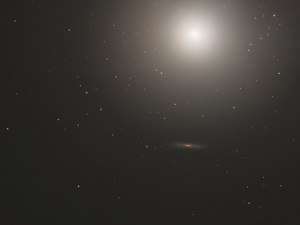Messier 89 (M89 for short, also known as NGC 4552) is an elliptical galaxy in the constellation Virgo. It was discovered by Charles Messier on March 18, 1781. M89 is a member of the Virgo Cluster of galaxies.[3]
| Messier 89[1] | |
|---|---|
 M89 by Hubble Space Telescope. | |
| Observation data (J2000 epoch) | |
| Constellation | Virgo |
| Right ascension | 12h 35m 39.8s[2] |
| Declination | +12° 33′ 23″[2] |
| Redshift | 0.001134±0.000014[2] |
| Heliocentric radial velocity | 340±4 km/s[2] |
| Galactocentric velocity | 290±5 km/s[2] |
| Distance | 50 ± 3 Mly (15.33 ± 0.92 Mpc) |
| Apparent magnitude (V) | 9.8[3] |
| Characteristics | |
| Type | E,[2] LINER,[2] HIISy2[2] |
| Apparent size (V) | 5.1 × 4.7 moa[2] |
| Other designations | |
| NGC 4552,[2] UGC 7760,[2] PGC 41968[2] | |
References: SIMBAD: Search M89 | |
Features
editCurrent observations allow the possibility that M89 may be nearly perfectly spherical. Distinct flattening as ellipsoids is found in all easily measurable comparators up to a few times of its distance. The alternative explanation is that it is an ellipsoid oriented so that it appears spherical to an observer on Earth.
The galaxy features a surrounding structure of gas and dust, extending up to 150,000 light-years and jets of heated particles up to two-thirds of that.[4] This indicates that it may have once been an active quasar or radio galaxy.[4] M89 has an extensive and complex system of surrounding shells and plumes, indicating that it has seen one or several notable mergers.[5]
Chandra studies in the wavelength of the X-Rays show two ring-like structures of hot gas in M89's nucleus, suggesting an outburst there 1 to 2 million years ago[6] as well as ram-pressure stripping acting on the galaxy as it moves through Virgo's intracluster medium.[7] The supermassive black hole at the core has a mass of (4.8±0.8)×108 M☉.[8]
M89 also has a large array of globular clusters. A 2006 survey estimates that there are 2,000 ± 700 of these within 25′. This compares to 150 to 200 of these thought (among which many proven) to surround the Milky Way.[9]
Gallery
edit-
Messier 89 by the Sloan Digital Sky Survey
-
Map of M89
-
HST image of M89
See also
editReferences
edit- ^ J. L. Tonry; A. Dressler; J. P. Blakeslee; E. A. Ajhar; et al. (2001). "The SBF Survey of Galaxy Distances. IV. SBF Magnitudes, Colors, and Distances". Astrophysical Journal. 546 (2): 681–693. arXiv:astro-ph/0011223. Bibcode:2001ApJ...546..681T. doi:10.1086/318301. S2CID 17628238.
- ^ a b c d e f g h i j k l "NASA/IPAC Extragalactic Database". Results for NGC 4552. Retrieved 2006-10-24.
- ^ a b "Elliptical Galaxy M89 @ SEDS Messier pages".
- ^ a b Messier Objects 81-90 @ Sea and Sky
- ^ Janowiecki, Steven; Mihos, J. Christopher; Harding, Paul; Feldmeier, John J.; et al. (2010). "Diffuse Tidal Structures in the Halos of Virgo Ellipticals". The Astrophysical Journal. 715 (2): 972–985. arXiv:1004.1473. Bibcode:2010ApJ...715..972J. doi:10.1088/0004-637X/715/2/972. S2CID 119196248.
- ^ Machacek, M.; Nulsen, P. E. J.; Jones, C.; Forman, W. R. (2014). "Chandra Observations of Nuclear Outflows in the Elliptical Galaxy NGC 4552 in the Virgo Cluster". The Astrophysical Journal. 648 (2): 947–955. arXiv:astro-ph/0604406. Bibcode:2006ApJ...648..947M. doi:10.1086/505963. S2CID 14060525.
- ^ Machacek, M.; Jones, C.; Forman, W. R.; Nulsen, P. (2006). "Chandra Observations of Gas Stripping in the Elliptical Galaxy NGC 4552 in the Virgo Cluster". The Astrophysical Journal. 644 (1): 155–166. arXiv:astro-ph/0508588. Bibcode:2006ApJ...644..155M. doi:10.1086/503350. S2CID 17223014.
- ^ Graham, Alister W. (November 2008), "Populating the Galaxy Velocity Dispersion - Supermassive Black Hole Mass Diagram: A Catalogue of (Mbh, σ) Values", Publications of the Astronomical Society of Australia, 25 (4): 167–175, arXiv:0807.2549, Bibcode:2008PASA...25..167G, doi:10.1071/AS08013, S2CID 89905.
- ^ Tamura, Naoyuki; Sharples, Ray M.; Arimoto, Nobuo; Onodera, Masato; et al. (2006). "A Subaru/Suprime-Cam wide-field survey of globular cluster populations around M87 - I. Observation, data analysis and luminosity function". Monthly Notices of the Royal Astronomical Society. 373 (2): 588–600. arXiv:astro-ph/0609067. Bibcode:2006MNRAS.373..588T. doi:10.1111/j.1365-2966.2006.11067.x. S2CID 15127905.
External links
edit- Media related to Messier 89 at Wikimedia Commons
- SEDS: Messier Object 89
- Messier 89 on WikiSky: DSS2, SDSS, GALEX, IRAS, Hydrogen α, X-Ray, Astrophoto, Sky Map, Articles and images